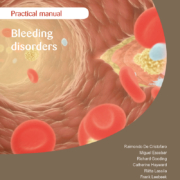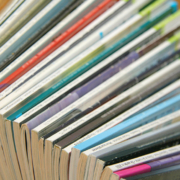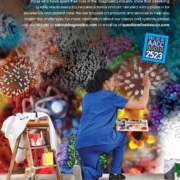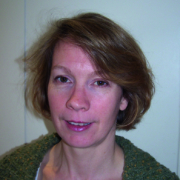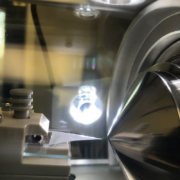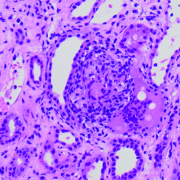Detection of viruses in clinical samples by use of metagenomic sequencing and targeted sequence capture
Wylie KM, Wylie TN, Buller R, Herter B, Cannella MT, Storch GA. J Clin Microbiol 2018; 56(12): pii: e01123-1
Metagenomic shotgun sequencing (MSS) is a revolutionary approach to viral diagnostic testing that allows simultaneous detection of a broad range of viruses, detailed taxonomic assignment, and detection of mutations associated with antiviral drug resistance. To enhance sensitivity for virus detection, we previously developed ViroCap, a targeted sequence capture panel designed to enrich nucleic acid from a comprehensive set of eukaryotic viruses prior to sequencing. To demonstrate the utility of MSS with targeted sequence capture for detecting clinically important viruses and characterizing clinically important viral features, we used ViroCap to analyse clinical samples from a diagnostic virology laboratory containing a broad range of medically relevant viruses. From 26 samples, MSS with ViroCap detected all of the expected viruses and 30 additional viruses. Comparing sequencing after capture enrichment with standard MSS, we detected 13 viruses only with capture enrichment and observed a consistent increase in the number and percentage of viral sequence reads as well as the breadth and depth of coverage of the viral genomes. Compared with clinical testing, MSS enhanced taxonomic assignment for 15 viruses, and codons associated with antiviral drug resistance in influenza A virus, herpes simplex virus (HSV), human immunodeficiency virus (HIV), and hepatitis C virus (HCV) could be analysed. Overall, in clinical samples, MSS with targeted sequence capture provides enhanced virus detection and information of clinical and epidemiologic relevance compared with clinical testing and MSS without targeted sequence capture.
Sonication versus tissue sampling for diagnosis of prosthetic joint and other orthopedic device-related infections
Dudareva M, Barrett L, Figtree M, Scarborough M, Watanabe M, et al. J Clin Microbiol 2018; 56(12): pii: e00688-18
Current guidelines recommend collection of multiple tissue samples for diagnosis of prosthetic joint infections (PJI). Sonication of explanted devices has been proposed as a potentially simpler alternative; however, reported microbiological yield varies. We evaluated sonication for diagnosis of PJI and other orthopedic device-related infections (DRI) at the Oxford Bone Infection Unit between October 2012 and August 2016. We compared the performance of paired tissue and sonication cultures against a ‘gold standard’ of published clinical and composite clinical and microbiological definitions of infection. We analysed explanted devices and a median of five tissue specimens from 505 procedures. Among clinically infected cases the sensitivity of tissue and sonication culture was 69% (95% confidence interval, 63 to 75) and 57% (50 to 63), respectively (P<0.0001). Tissue culture was more sensitive than sonication for both PJI and other DRI, irrespective of the infection definition used. Tissue culture yield was higher for all subgroups except less virulent infections, among which tissue and sonication culture yield were similar. The combined sensitivity of tissue and sonication culture was 76% (70 to 81) and increased with the number of tissue specimens obtained. Tissue culture specificity was 97% (94 to 99), compared with 94% (90 to 97) for sonication (P=0.052) and 93% (89 to 96) for the two methods combined. Tissue culture is more sensitive and may be more specific than sonication for diagnosis of orthopedic DRI in our setting. Variable methodology and case mix may explain reported differences between centres in the relative yield of tissue and sonication culture. Culture yield was highest for both methods combined.
MODS-Wayne, a colorimetric adaptation of the microscopic-observation drug susceptibility (MODS) assay for detection of Mycobacterium tuberculosis pyrazinamide resistance from sputum samples
Alcántara R, Fuentes P, Antiparra R, Santos M, Gilman RH, et al. J Clin Microbiol 2019; 57(2): pii: e01162-18
Although pyrazinamide (PZA) is a key component of first- and second-line tuberculosis treatment regimens, there is no gold standard to determine PZA resistance. Approximately 50% of multidrug-resistant tuberculosis (MDR-TB) and over 90% of extensively drug-resistant tuberculosis (XDR-TB) strains are also PZA resistant. pncA sequencing is the endorsed test to evaluate PZA susceptibility. However, molecular methods have limitations for their wide application. In this study, we standardized and evaluated a new method, MODS-Wayne, to determine PZA resistance. MODS-Wayne is based on the detection of pyrazinoic acid, the hydrolysis product of PZA, directly in the supernatant of sputum cultures by detecting a colour change following the addition of 10% ferrous ammonium sulfate. Using a PZA concentration of 800 µg/mL, sensitivity and specificity were evaluated at three different periods of incubation (reading 1, reading 2, and reading 3) using a composite reference standard (MGIT-PZA, pncA sequencing, and the classic Wayne test). MODS-Wayne was able to detect PZA resistance, with a sensitivity and specificity of 92.7% and 99.3%, respectively, at reading 3. MODS-Wayne had an agreement of 93.8% and a kappa index of 0.79 compared to the classic Wayne test, an agreement of 95.3% and kappa index of 0.86 compared to MGIT-PZA, and an agreement of 96.9% and kappa index of 0.90 compared to pncA sequencing. In conclusion, MODS-Wayne is a simple, fast, accurate, and inexpensive approach to detect PZA resistance, making this an attractive assay especially for low-resource countries, where TB is a major public health problem.
Barriers and facilitators and the need for a clinical guideline for microbiological diagnostic testing in the hospital: a qualitative and quantitative study
Bogers SJ, van Daalen FV, Kuil SD, de Jong MD, Geerlings SE. Eur J Clin Microbiol Infect Dis 2019; doi: 10.1007/s10096-019-03516-z [Epub ahead of print]
The appropriate use of microbiological investigations is an important cornerstone of antibiotic stewardship programmes, but receives relatively limited attention. This study aimed to identify influencing factors in performing microbiological diagnostic tests and to assess the need for a clinical guideline. We performed a qualitative (focus group) and quantitative (online questionnaire survey) study among medical specialists and residents to identify physicians’ considerations in performing microbiological diagnostic tests and to assess the need for a diagnostic guideline. The questionnaire consisted of 14 statements, divided into three categories: knowledge, influencing factors and presence of guidelines. The questionnaire was sent to physicians of the departments of internal medicine, intensive care, pediatrics and pulmonology in five hospitals in the Netherlands. Sub-analyses for medical specialists versus residents and for pediatric versus non-pediatric departments were performed. We included 187 completed questionnaires in our analyses. The physicians reported having adequate knowledge on methods, time-to-result and accuracy, but inadequate knowledge on costs of the tests. Patients’ clinical condition, comorbidity, local guidelines and accuracy of tests were appraised as the four most important influencing factors to perform tests. Over 70% (132/187) of physicians reported being interested in a guideline for microbiological diagnostic testing. Fifteen physicians (8.0%) provided additional comments. This study identifies the influencing factors to microbiological testing and shows the demand for a clinical guideline among physicians. IMPORTANCE: Microbiological diagnostic tests are an important cornerstone within antibiotic stewardship programmes. These programmes aim to ameliorate the appropriate use of antibiotics and thus improve clinical outcomes of infectious diseases, whilst reducing the emergence of antimicrobial resistance. However, inappropriate microbiological testing is a widely recognized problem, and influencing factors to testing have not been studied in the past. Our research shows the demand for a clinical guideline among physicians, and it identifies their influencing factors to testing. These results can be used to create a clinical guideline for microbiological diagnostic testing, thus supporting antibiotic stewardship programmes and reducing antimicrobial resistance.
Understanding and overcoming the pitfalls and biases of next-generation sequencing (NGS) methods for use in the routine clinical microbiological diagnostic laboratory
Boers SA, Jansen R, Hays JP. Eur J Clin Microbiol Infect Dis 2019; doi: 10.1007/s10096-019-03520-3 [Epub ahead of print]
Recent advancements in next-generation sequencing (NGS) have provided the foundation for modern studies into the composition of microbial communities. The use of these NGS methods allows for the detection and identification of (‘difficult-to-culture’) microorganisms using a culture-independent strategy. In the field of routine clinical diagnostics, however, the application of NGS is currently limited to microbial strain typing for epidemiological purposes only, even though the implementation of NGS for microbial community analysis may yield clinically important information. This lack of NGS implementation is due to many different factors, including issues relating to NGS method standardization and result reproducibility. In this review article, the authors provide a general introduction to the most widely used NGS methods currently available (i.e. targeted amplicon sequencing and shotgun metagenomics) and the strengths and weaknesses of each method is discussed. The focus of the publication then shifts toward 16S rRNA gene NGS methods, which are currently the most cost-effective and widely used NGS methods for research purposes, and are therefore more likely to be successfully implemented into routine clinical diagnostics in the short term. In this respect, the experimental pitfalls and biases created at each step of the 16S rRNA gene NGS workflow are explained, as well as their potential solutions. Finally, a novel diagnostic microbiota profiling platform (‘MYcrobiota’) is introduced, which was developed by the authors by taking into consideration the pitfalls, biases, and solutions explained in this article. The development of the MYcrobiota, and future NGS methodologies, will help pave the way toward the successful implementation of NGS methodologies into routine clinical diagnostics.
A pan-genotypic Hepatitis C Virus NS5A amplification method for reliable genotyping and resistance testing
Walker A, Ennker KS, Kaiser R, Lübke N, Timm J. J Clin Virol 2019; 113: 8–13
BACKGROUND: Chronic infection with the Hepatitis C Virus (HCV) is associated with the risk of progressive liver disease. Although, HCV treatment options and viral cure rates have tremendously increased over the last decade, all currently licensed combination therapies contain inhibitors of the replication complex NS5A. Resistance-associated substitutions (RAS) in NS5A can limit the efficacy of therapy; however, resistance testing is routinely not recommended for all patients. Notably, pan-genotypic combinations have been approved; however, the correct identification of the HCV genotype is still required for treatment decisions and is a good predictor for treatment success.
OBJECTIVE: The aim of this study was the establishment of a pan-genotypic NS5A amplification method for reliable genotyping and simultaneous resistance testing in a fast and cheap routine diagnostic setup.
STUDY DESIGN: Pan-genotypic degenerated nested PCR primer were designed and tested in 262 HCV-patients. The collection included samples from genotypes 1–7 and the median viral load was 1.07×106 IU/mL (range 248–21×106 IU/mL).
RESULTS: Amplification of the expected 747 bp fragment was successful in 257 of 262 (98.1%) samples including samples <1000 IU/mL. The direct comparison of the genotype information obtained with core sequencing to those obtained by NS5A prediction showed high concordance (97.3%) and discrepancies occurred only for relatively rare subtypes. Resistance analysis using Geno2Pheno[HCV] showed NS5A-RAS in 23 of 257 (8.9%) of samples.
CONCLUSIONS: We successfully developed a routine diagnostic method for pan-genotypic amplification of NS5A. This amplicon can be used for simultaneous genotyping and resistance testing for enhancing and improving routine HCV diagnostic.
Impact of multiplex molecular assay turn-around-time on antibiotic utilization and clinical management of hospitalized children with acute respiratory tract infections
Lee BR, Hassan F, Jackson MA, Selvarangan R. J Clin Virol 2019; 110: 11–16
BACKGROUND: Empiric antibiotic treatment is common among children with acute respiratory tract infections (ARTI), despite infections being predominately viral. The use of molecular respiratory panel assays has become increasingly common for medical care of patients with ARTIs.
STUDY DESIGN: This was a 6-year retrospective, single-centred study of pediatric inpatients who tested positive for an ARTI respiratory pathogen. We examined the relationship between clinical outcomes and whether the patient was tested using the Luminex Respiratory Viral Panel ([RVP]; in-use: Dec 2009 – Jul 2012) or Biofire Respiratory Pathogen Panel ([RP]; in-use Aug 2012 – Jun 2016). The prevalence and duration of pre-test empiric antibiotics, post-test oseltamivir administration to influenza patients, chest X-rays and length of stay between the two assays was compared.
RESULTS: A total of 5142 patients (1264 RVP; 3878 RP) were included. The median laboratory turn-around-time for RP was significantly shorter than RVP (1.4 vs 27.1 h, respectively; P<0.001). Patients tested with RP were less likely to receive empiric antibiotics (OR: 0.45; P<0.001; 95% CI: 0.39, 0.52) and had a shorter duration of empiric broad-spectrum antibiotics (6.4 h vs 32.9 h; P<0.001) compared to RVP patients. RP influenza patients had increased oseltamivir use post- test compared to RVP influenza patients (OR: 13.56; P<0.001; 95% CI: 7.29, 25.20).
CONCLUSIONS: Rapid molecular testing positively impacts patient management of ARTIs. Adopting assays with a shorter turn-around-time improves decision making by decreasing empirical antibiotic use and duration, decreasing chest X-rays, increasing timely oseltamivir administration, and reducing length of stay.
Practical guidance for clinical microbiology laboratories: viruses causing acute respiratory tract infections
Charlton CL, Babady E, Ginocchio CC, Hatchette TF, Jerris RC, et al. Clin Microbiol Rev 2018; 32(1): pii: e00042-18
Respiratory viral infections are associated with a wide range of acute syndromes and infectious disease processes in children and adults worldwide. Many viruses are implicated in these infections, and these viruses are spread largely via respiratory means between humans but also occasionally from animals to humans. This article is an American Society for Microbiology (ASM)-sponsored Practical Guidance for Clinical Microbiology (PGCM) document identifying best practices for diagnosis and characterization of viruses that cause acute respiratory infections and replaces the most recent prior version of the ASM-sponsored Cumitech 21 document, Laboratory Diagnosis of Viral Respiratory Disease, published in 1986. The scope of the original document was quite broad, with an emphasis on clinical diagnosis of a wide variety of infectious agents and laboratory focus on antigen detection and viral culture. The new PGCM document is designed to be used by laboratorians in a wide variety of diagnostic and public health microbiology/virology laboratory settings worldwide. The article provides guidance to a rapidly changing field of diagnostics and outlines the epidemiology and clinical impact of acute respiratory viral infections, including preferred methods of specimen collection and current methods for diagnosis and characterization of viral pathogens causing acute respiratory tract infections. Compared to the case in 1986, molecular techniques are now the preferred diagnostic approaches for the detection of acute respiratory viruses, and they allow for automation, high-throughput workflows, and near-patient testing. These changes require quality assurance programs to prevent laboratory contamination as well as strong preanalytical screening approaches to utilize laboratory resources appropriately. Appropriate guidance from laboratorians to stakeholders will allow for appropriate specimen collection, as well as correct test ordering that will quickly identify highly transmissible emerging pathogens.
Matrix-assisted laser desorption ionization-time of flight mass spectrometry for the rapid detection of antimicrobial resistance mechanisms and beyond
Oviaño M, Bou G. Clin Microbiol Rev 2018; 32(1): pii: e00037-18
Matrix-assisted laser desorption ionization-time of flight mass spectrometry (MALDI-TOF MS) has been successfully applied in recent years for first-line identification of pathogens in clinical microbiology because it is simple to use, rapid, and accurate and has economic benefits in hospital management. The range of clinical applications of MALDI-TOF MS for bacterial isolates is increasing constantly, from species identification to the two most promising applications in the near future: detection of antimicrobial resistance and strain typing for epidemiological studies. The aim of this review is to outline the contribution of previous MALDI-TOF MS studies in relation to detection of antimicrobial resistance and to discuss potential future challenges in this field. Three main approaches are ready (or almost ready) for clinical use, including the detection of antibiotic modifications due to the enzymatic activity of bacteria, the detection of antimicrobial resistance by analysis of the peak patterns of bacteria or mass peak profiles, and the detection of resistance by semiquantification of bacterial growth in the presence of a given antibiotic. This review provides an expert guide for MALDI-TOF MS users to new approaches in the field of antimicrobial resistance detection, especially possible applications as a routine diagnostic tool in microbiology laboratories.



